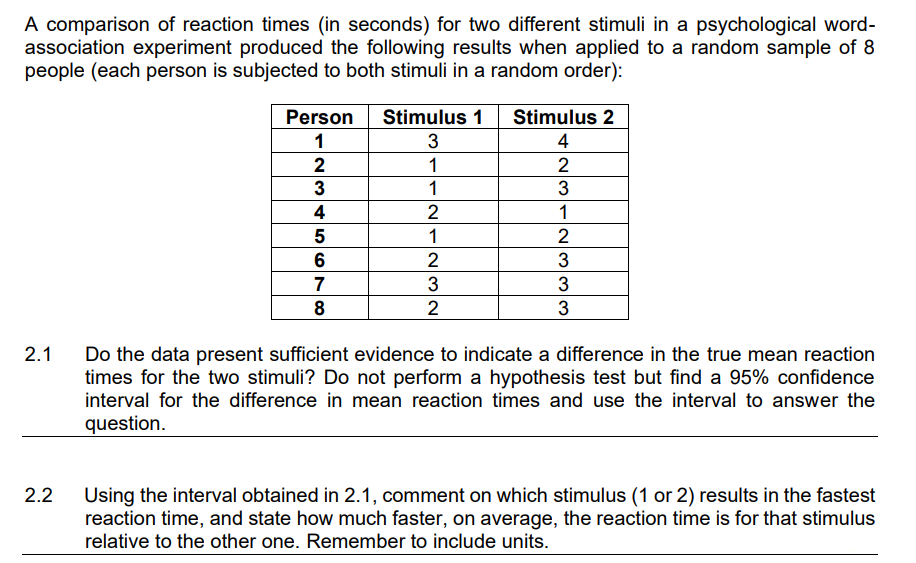A comparison of reaction times (in seconds) for two different stimuli in a psychological word- association experiment produced the following results when applied to a random sample of 8 people (each person is subjected to both stimuli in a random order): Person Stimulus 1 Stimulus 2 1 3 4 2 1 2 3 1 3 4 2 1 5 1 2 6 2 7 8 2 3 2.1 Do the data present sufficient evidence to indicate a difference in the true mean reaction times for the two stimuli? Do not perform a hypothesis test but find a 95% confidence interval for the difference in mean reaction times and use the interval to answer the question. 2.2 Using the interval obtained in 2.1, comment on which stimulus (1 or 2) results in the fastest reaction time, and state how much faster, on average, the reaction time is for that stimulus relative to the other one. Remember to include units.
A comparison of reaction times (in seconds) for two different stimuli in a psychological word- association experiment produced the following results when applied to a random sample of 8 people (each person is subjected to both stimuli in a random order): Person Stimulus 1 Stimulus 2 1 3 4 2 1 2 3 1 3 4 2 1 5 1 2 6 2 7 8 2 3 2.1 Do the data present sufficient evidence to indicate a difference in the true mean reaction times for the two stimuli? Do not perform a hypothesis test but find a 95% confidence interval for the difference in mean reaction times and use the interval to answer the question. 2.2 Using the interval obtained in 2.1, comment on which stimulus (1 or 2) results in the fastest reaction time, and state how much faster, on average, the reaction time is for that stimulus relative to the other one. Remember to include units.
MATLAB: An Introduction with Applications
6th Edition
ISBN:9781119256830
Author:Amos Gilat
Publisher:Amos Gilat
Chapter1: Starting With Matlab
Section: Chapter Questions
Problem 1P
Related questions
Question

Transcribed Image Text:A comparison of reaction times (in seconds) for two different stimuli in a psychological word-
association experiment produced the following results when applied to a random sample of 8
people (each person is subjected to both stimuli in a random order):
Stimulus 1
Stimulus 2
Person
1
3
4
2
1
2
1
3
4
2
1
1
2
6
2
3
7
3
8
2
3
2.1
Do the data present sufficient evidence to indicate a difference in the true mean reaction
times for the two stimuli? Do not perform a hypothesis test but find a 95% confidence
interval for the difference in mean reaction times and use the interval to answer the
question.
Using the interval obtained in 2.1, comment on which stimulus (1 or 2) results in the fastest
reaction time, and state how much faster, on average, the reaction time is for that stimulus
relative to the other one. Remember to include units.
2.2
Expert Solution
This question has been solved!
Explore an expertly crafted, step-by-step solution for a thorough understanding of key concepts.
This is a popular solution!
Trending now
This is a popular solution!
Step by step
Solved in 6 steps

Recommended textbooks for you

MATLAB: An Introduction with Applications
Statistics
ISBN:
9781119256830
Author:
Amos Gilat
Publisher:
John Wiley & Sons Inc

Probability and Statistics for Engineering and th…
Statistics
ISBN:
9781305251809
Author:
Jay L. Devore
Publisher:
Cengage Learning

Statistics for The Behavioral Sciences (MindTap C…
Statistics
ISBN:
9781305504912
Author:
Frederick J Gravetter, Larry B. Wallnau
Publisher:
Cengage Learning

MATLAB: An Introduction with Applications
Statistics
ISBN:
9781119256830
Author:
Amos Gilat
Publisher:
John Wiley & Sons Inc

Probability and Statistics for Engineering and th…
Statistics
ISBN:
9781305251809
Author:
Jay L. Devore
Publisher:
Cengage Learning

Statistics for The Behavioral Sciences (MindTap C…
Statistics
ISBN:
9781305504912
Author:
Frederick J Gravetter, Larry B. Wallnau
Publisher:
Cengage Learning

Elementary Statistics: Picturing the World (7th E…
Statistics
ISBN:
9780134683416
Author:
Ron Larson, Betsy Farber
Publisher:
PEARSON

The Basic Practice of Statistics
Statistics
ISBN:
9781319042578
Author:
David S. Moore, William I. Notz, Michael A. Fligner
Publisher:
W. H. Freeman

Introduction to the Practice of Statistics
Statistics
ISBN:
9781319013387
Author:
David S. Moore, George P. McCabe, Bruce A. Craig
Publisher:
W. H. Freeman